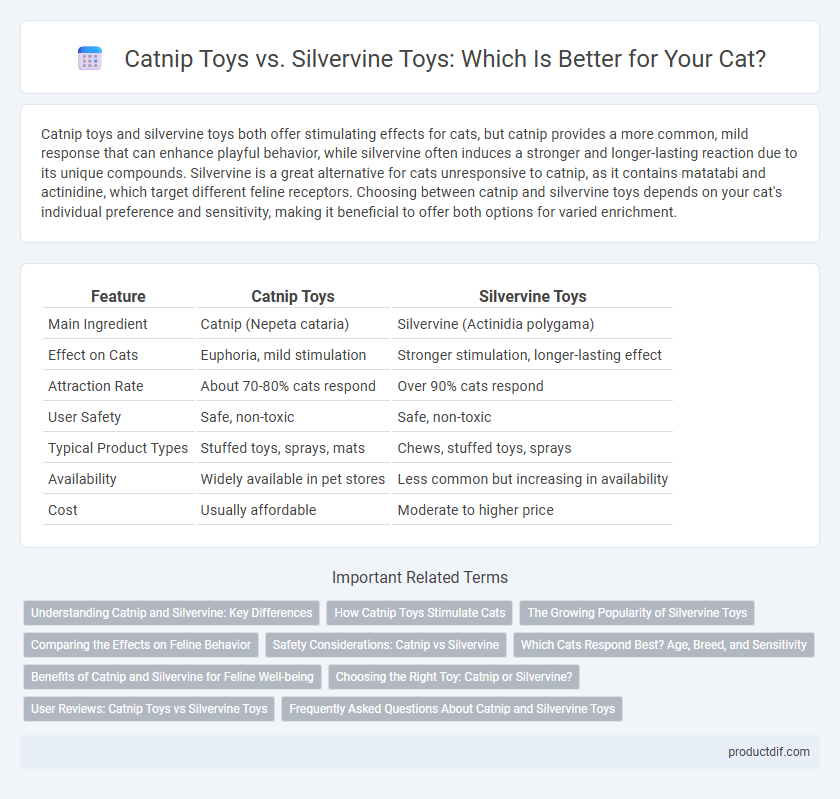Catnip toys and silvervine toys both offer stimulating effects for cats, but catnip provides a more common, mild response that can enhance playful behavior, while silvervine often induces a stronger and longer-lasting reaction due to its unique compounds. Silvervine is a great alternative for cats unresponsive to catnip, as it contains matatabi and actinidine, which target different feline receptors. Choosing between catnip and silvervine toys depends on your cat's individual preference and sensitivity, making it beneficial to offer both options for varied enrichment.
Table of Comparison
| Feature | Catnip Toys | Silvervine Toys |
|---|---|---|
| Main Ingredient | Catnip (Nepeta cataria) | Silvervine (Actinidia polygama) |
| Effect on Cats | Euphoria, mild stimulation | Stronger stimulation, longer-lasting effect |
| Attraction Rate | About 70-80% cats respond | Over 90% cats respond |
| User Safety | Safe, non-toxic | Safe, non-toxic |
| Typical Product Types | Stuffed toys, sprays, mats | Chews, stuffed toys, sprays |
| Availability | Widely available in pet stores | Less common but increasing in availability |
| Cost | Usually affordable | Moderate to higher price |
Understanding Catnip and Silvervine: Key Differences
Catnip toys contain Nepeta cataria, which triggers a strong olfactory response in about 70-80% of cats due to the compound nepetalactone, inducing euphoria and playfulness. Silvervine toys, derived from Actinidia polygama, offer an alternative for cats unresponsive to catnip, containing actinidine and dihydroactinidiolide that stimulate the feline's sensory system differently. Understanding these key differences helps pet owners select the most effective and engaging toy based on their cat's unique sensitivity to these plant-based stimulants.
How Catnip Toys Stimulate Cats
Catnip toys stimulate cats by triggering their olfactory receptors with nepetalactone, a compound that induces playful and euphoric behavior, enhancing physical activity and mental engagement. This natural interaction promotes exercise and reduces stress, supporting overall feline health. Silvervine lacks nepetalactone but offers alternative compounds stimulating cats differently, making catnip toys uniquely effective for olfactory-driven play.
The Growing Popularity of Silvervine Toys
Silvervine toys have surged in popularity among cat owners due to their potent effects and appeal to cats that show no interest in traditional catnip toys. Unlike catnip, which contains nepetalactone, silvervine contains actinidine and other compounds that stimulate a broader range of feline sensory receptors. This makes silvervine toys an increasingly preferred choice for enhancing feline play and enrichment.
Comparing the Effects on Feline Behavior
Catnip toys typically stimulate playful and euphoric behavior in about 50-70% of cats, triggering rolling, purring, and rubbing due to the active compound nepetalactone. Silvervine toys, containing actinidine and dihydroactinidiolide, often produce a stronger and longer-lasting response in cats, including licking, chewing, and heightened activity, appealing to cats unresponsive to catnip. Behavioral effects of silvervine tend to be more diverse and intense, making silvervine toys a preferred choice for owners seeking alternative enrichment for their felines.
Safety Considerations: Catnip vs Silvervine
Catnip toys are generally safe for most cats, but excessive exposure can lead to mild digestive upset or overstimulation. Silvervine toys often provide a safer alternative for cats that do not react to catnip, as silvervine contains actinidine and dihydroactinidiolide, compounds typically well-tolerated and less likely to cause adverse reactions. Monitoring your cat's response to each toy is crucial to ensure safety, especially in cats with sensitivities or pre-existing health conditions.
Which Cats Respond Best? Age, Breed, and Sensitivity
Cats with heightened olfactory sensitivity, including breeds like Siamese and Maine Coon, tend to respond more enthusiastically to catnip toys, especially during their adult stage from 3 to 10 years. Silvervine toys often attract cats who show little or no interest in catnip, including kittens under 6 months and older cats over 10 years, due to different active compounds like actinidine and dihydroactinidiolide. Sensitivity to these plants also varies individually, with some felines displaying strong reactions to silvervine's dual stimulation properties, making it ideal for cats with low or no response to catnip.
Benefits of Catnip and Silvervine for Feline Well-being
Catnip contains nepetalactone, which activates sensory neurons in cats, promoting playful behavior and reducing stress, making it ideal for feline enrichment and mental stimulation. Silvervine offers a stronger euphoric reaction due to its actinidine and dihydroactinidiolide compounds, benefiting cats that are less responsive to catnip and enhancing physical activity. Both substances contribute to feline well-being by encouraging exercise, alleviating anxiety, and providing a natural source of entertainment.
Choosing the Right Toy: Catnip or Silvervine?
Choosing between catnip toys and silvervine toys depends on your cat's unique sensory preferences and reaction to these plants. Catnip contains nepetalactone, which triggers playful and euphoric behavior in about 70-80% of cats, while silvervine offers a stimulating effect suitable for cats unresponsive to catnip, containing compounds like actinidine and dihydroactinidiolide. Opting for silvervine toys may provide a more intense or prolonged response, especially beneficial for cats that ignore catnip, ensuring enriched playtime and mental stimulation.
User Reviews: Catnip Toys vs Silvervine Toys
User reviews highlight that catnip toys often provide mild stimulation, making them suitable for sensitive or younger cats, whereas silvervine toys deliver more intense reactions and longer-lasting excitement for most felines. Many cat owners note that silvervine toys tend to engage cats who are indifferent to catnip, increasing playtime and exercise. Both toys receive praise for improving cat activity levels, but silvervine consistently ranks higher in overall user satisfaction and repeat use.
Frequently Asked Questions About Catnip and Silvervine Toys
Catnip toys contain Nepeta cataria, which induces euphoric behaviors in approximately 50-70% of cats, while silvervine toys feature Actinidia polygama, effective in up to 80% of cats, especially those unresponsive to catnip. Both toys stimulate play and mental activity, but silvervine's unique chemical compounds, actinidine and dihydroactinidiolide, provide a stronger response in kittens and older cats. Frequently asked questions include differences in sensitivity, longevity of effects, and potential allergies, with silvervine often preferred for cats that do not react to catnip.
Catnip Toys vs Silvervine Toys Infographic

 productdif.com
productdif.com